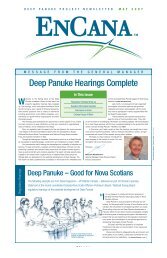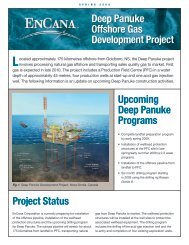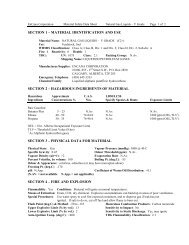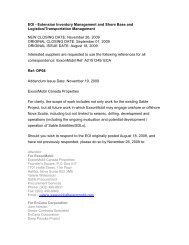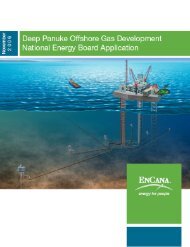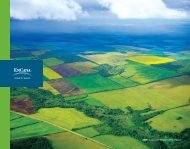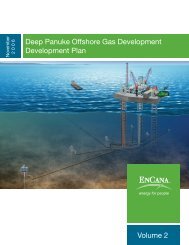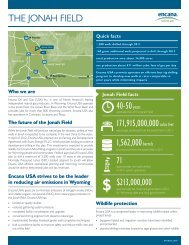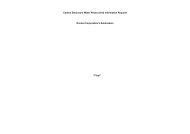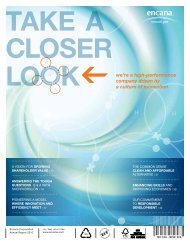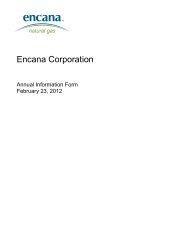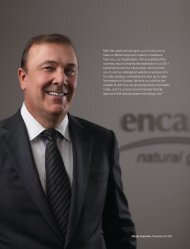Deep Panuke Project Description - Encana
Deep Panuke Project Description - Encana
Deep Panuke Project Description - Encana
Create successful ePaper yourself
Turn your PDF publications into a flip-book with our unique Google optimized e-Paper software.
Table 2.9 <strong>Deep</strong> <strong>Panuke</strong> Potential Drilling Waste Discharge SummaryEach New One New Each Re-entry Total DischargesProduction Well Injection Well Production WellSeabed release of WBM associated 131 131 0 656cuttings (m 3 )Surface release of WBM associated 427 356 0 2062cuttings (m 3 )Seabed release of WBM on180 180 0 900cuttings (m 3 )Surface release of WBM on64 53 0 309cuttings (m 3 )Surface release of WBM (bulk mud 700 600 0 3400release) (m 3 )Surface release of completion fluid 1000 300 300 5500(m 3 )Notes:All volumes are approximations that represent each well’s discharges.Using a conservative approach to dispersion modelling, it is assumed four existing wells will be re-completed using completion fluid (“reentry”production wells), and four new production wells and one new injection well will be drilled using WBM with overboard discharge.The completion fluid is a brine (NaCl) with various additives for oxygen scavengers, H 2 S scavengers and corrosion protection in somecases.Prior to use, all chemicals will be screened using the CNSOPB Offshore Chemical Selection Guidelines2.7.5 Effluent Discharges2.7.5.1 Produced WaterProduced water management is described in Section 2.4.1.8. Produced water will be treated to a targetdispersed oil concentration of 25 mg/L (30-day weighted average). The OWTG specify a 30-dayweighted average of 30 mg/L. Refer to Appendix D for results of produced water dispersion modelling.2.7.5.2 Cooling WaterThe cooling system will use seawater to indirectly cool a circulating medium (40% ethylene glycol, 60%water (volume)) solution. The cooling water flow rate will be constant at 2,400 m 3 /hr and will have atemperature approximately 15°C above background water temperature. It will be mixed with producedwater before discharge.The seawater is treated with chlorine generated by a sodium hypochlorite generator to prevent/reduce thegrowth of marine biological growth. The design chlorine concentration at the seawater lift pump inlet is 2ppm (1 ppm during normal operation with an increase during periods of high larval mussel concentration).The residual free chlorine concentration at the outlet will normally be below 0.25 ppm. The combinedproduced water and cooling water stream exit temperature will not exceed 25 o C above ambient.<strong>Deep</strong> <strong>Panuke</strong> Volume 4 (Environmental Assessment Report)• November 2006 2-55




